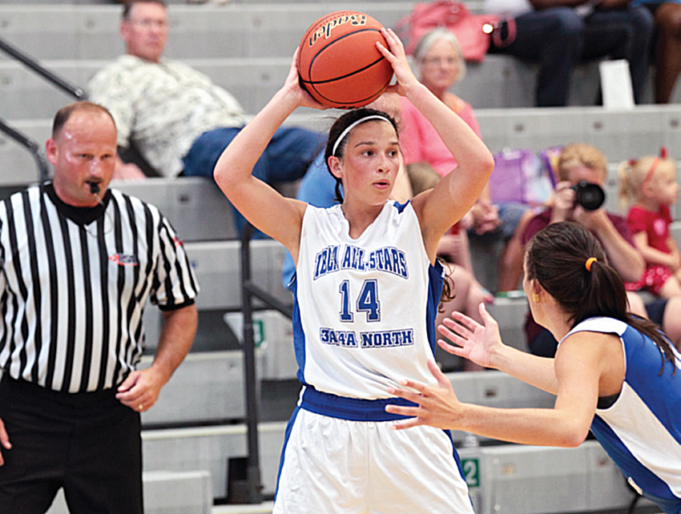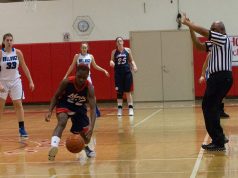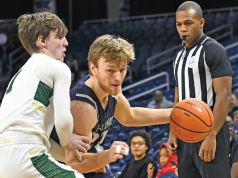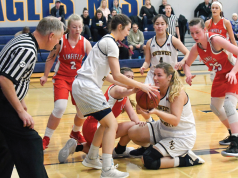Interested in working a fast paced game where things are happening quickly, requiring you to stay completely focused? Then let’s partner together as a two-person crew for a high school varsity basketball contest.
The game of basketball was founded with the idea of using two people to officiate the game. They would split the court, work as a team and manage their respective areas. As the players became bigger and faster and the game advanced, three-person mechanics were introduced and are now used at the professional and collegiate levels and at the varsity level in many high schools across the country. The third person on the court allows each official to observe a smaller area. And because more officials are needed, it creates opportunities for younger officials to advance to the varsity level. For those officials working high schools that use two-person mechanics, however, it is critically important they focus all their attention on their primary area throughout the game. Drifting outside your coverage area will lead to missed action on the court and will diminish the continuity between partners.
Crews must work hard at all aspects of their craft in order to maintain the high level of two-person mechanics today’s game requires. Let’s review a few here. The following will help you to cover the court, maintain control of the game and allow you to remain consistent from the tip to the final horn.
Stay in your coverage area
Each official has specific areas of coverage on the court. For the trail, the primary coverage area consists of the division line to the endline, up to the free-throw lane line on their side of the court. That coverage includes sideline to sideline above the freethrow line extended, and division line responsibility. The lead’s primary coverage area consists of endline to endline, the free-throw lane and their sideline below the free-throw line extended. Consult your officials manual and other publications for additional court coverage study.
What’s important to remember is the focus should be on action within your primary coverage area and not necessarily the ball. By following the ball exclusively, your eyes will take you outside your coverage area and invariably a foul or violation will be missed. To help prevent that from happening, partners must know their coverage area and have complete trust in each other’s ability as an official. Have the confidence in your partner to do the same solid job in his or her coverage area as you will do in yours. That’s the definition of a crew working in tandem. Conducting a solid and thorough pregame will go a long way to building trust and forming that partnership on the court. Start your game with that frame of mind and you will limit the chance of the lead ruling a foul above the freethrow semicircle or the trail whistling a traveling violation near the endline. Those types of long-distance calls will propel the coach up from the bench and make the crew appear out of sync. Keep your attention level exactly where it belongs. Avoid officiating with “four eyes on the ball.”
Switch after fouls
Switching after fouls is important because it keeps officials alert, on the move and allows coaches to see them working as a crew. After the foul is called, the calling official will observe action from both benches while moving directly to the reporting area. The non-calling official freezes his or her field of vision to observe the action on the court. When a foul occurs in a two-person game, the emphasis must be on observing the action. The areas you are observing during foul reporting are now your primary coverage areas. After a foul, adrenaline levels are high, and perhaps tempers, too. Not maintaining a concentrated focus can result in missing unsporting action on the court or bench area. After reporting, the proper switch is conducted, and play is ready to continue.
Match-ups
In two person, an official needs to play the percentages and pick which matchups deserve the most attention. Let’s gameplan the high screen and roll (or hedge play) at the top of the arc. It occurs solely in the trail’s primary. But there’s likely four bodies (two offense/ two defense) in a confined space, including an aggressive matchup with the ball. If the on-ball defense is so aggressive, it’s likely difficult for the trail to determine the setup of the screener and the legality of the contact involving any potential hedge defender. It’s just not possible or probable that you can direct your attention as the trail away from the on-ball matchup with pressed coverage. So even if the lead official would have an engaged matchup in the post, isn’t he or she better served to direct their attention toward that high screen and watch that action start, develop and finish? That’s why you have to know how aggressive the defense is involving the on-ball defender. Then direct attention back to any post matchup. The lead plays the percentage, the crew has a better chance to get that important play right and now both can direct their attention elsewhere (trail stays with ball, lead picks up post or screener rolling to the basket).
Of course, there is no substitute for hustle. In a two-person game, officials are running harder and more often. Aspire to be the crew that demonstrates hustle, displays proper court coverage and shows teamwork and trust.
What's Your Call? Leave a Comment:
Note: This article is archival in nature. Rules, interpretations, mechanics, philosophies and other information may or may not be correct for the current year.
This article is the copyright of ©Referee Enterprises, Inc., and may not be republished in whole or in part online, in print or in any capacity without expressed written permission from Referee. The article is made available for educational use by individuals.

















